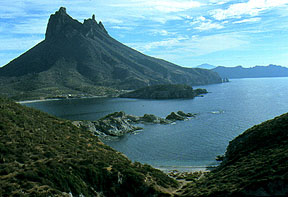Sonora--Mexico's
Wild West
by Bob Brooke
Continued...
 By
the Bay of San Carlos By
the Bay of San Carlos
The names San Carlos, Bahia San Carlos, and San Carlos Bay, all refer to
an area about seven miles northwest of Guaymas which includes Playa San
Francisco, a long stretch of stony beach paralleling the coastal
highway., the yacht harbor at Bahia San Carlos formed by two rocky
peninsulas that jut into the Sea of Cortez, and the curving, sandy beach
of Playa los Algodones on Bahia de Sonora. Backed by the 2,000-foot
Sierra de Baccochibampo, the area is one of the most scenic along the
coasts of Northern Mexico.
Mostly American retirees
live in settlements that dot the cactus covered hills above the
brilliant turquoise Bahia San Carlos. Prime real estate is available for
sale and there are motels, hotels, RV Parks, condominiums and private
home rentals to fit every group and budget. Prices start at $45/night or
$450/month. While the resort has 2,000 year-round residents, the
population swells as high as 6,000 during the peak tourist season.
The community hosts an
18-hole championship golf course, tennis courts, a bowling alley and
numerous gift shops and galleries for shopping and browsing. For the
boater, two marinas with 700 boat slips offer paved launch ramps, dry
storage facilities, complete marine repair and maintenance services,
fuel docks and reasonable rates for slip rental. San Carlos boasts
numerous restaurants featuring seafood, Sonoran beef, Mexican dishes and
American cuisine.
San Carlos offers one of the finest sailing venues in the Sea of Cortez.
Magnificent mountain vistas, secluded coves and bays for anchoring out
and deep water combined with complete marina services and storm safe
anchorages make San Carlos a sailing paradise.
With more than 800
varieties of maritime species San Carlos ranks second in the world for
sport fishing. During summer months, as the water temperatures rise, the
exotic big game species are present, including marlin, sailfish, dorado
(mahi-mahi) and tuna. From late fall into spring, there's excellent
bottom fishing for red snapper, sea trout, yellowtail, and sea bass in
and around the many islands.
Diving is one of the most
popular passions of visitors to San Carlos, whether you're a first-timer
or a veteran. Crystal clear and constantly calm waters, plus two
artificial reefs, a sunken ferry and several smaller wrecks make the San
Carlos an ideal place to learn and visit repeatedly.
As I sit on my balcony at
the Howard Johnson San Carlos Plaza, I watch a pelican as it skims
across the still morning water. The sky glows lavender and pink.
Suddenly, a small flock of cormorants appears, floating in unison on the
surface of the water, disappearing to fish and again reappearing,
repeating the process over and over. The warm air hugs the coast of the
Bahia San Carlos where desert meets the sea. As the sun reaches ever
higher, it shines strong, reflecting off still waters. Perhaps, I'll
head over to Playa Algodones, or "Cotton Beach," as it's known
by the snowbirds, because of its fine white sand. Perhaps not.
After a couple of days
soaking up the sun in San Carlos, I head down the autopista south
of Guaymas. Stately Saguaros appear once again. The land is flat,
rolling to the horizon covered with low scrub, mesquite trees and a few
cacti. Cattle and horses graze randomly along the road to Cuidad Obregon.
These are the Plains of Sonora stretching below Guaymas.
Yaqui Country
I drive through Yaqui country. Over 50,000 of them live in seven towns
with names like Becum, Bacum and Belim. Ciudad Obregon lies at the
entrance to the Yaqui Valley, a fertile farming region where man makes
the desert bloom through drip irrigation.
Along the way, I stop to
visit Tres Marias, a big-game ranch. Here five or six people can stay in
the cozy rancho and hunt eight species of animals, including red and
white-tailed deer and antelope, which are raised for hunting, Texas Dall
Sheep, Wapiti elk, and pheasant, as well as mountain sheep, which roam
over open ranges. All for $125 per day, including room, board,
transfers, and beverages. I found out this is a big industry in Sonora.
Leaving the big-game
ranch, I follow the mountains past orange groves and mesquite into the
wide open spaces on the way to Alamos. I arrive in the late afternoon
about four hours later. Cowboys on horseback jockey for position with
cars and 4x4s in the town's narrow, cobble-stoned streets. There's a
quaint peacefulness here that seems to be missing in Hermosillo and San
Carlos. Maybe it's the Old Mexico atmosphere of thick adobe walls and a
clanging church bell.
<<Previous
Page Next Page>> |

